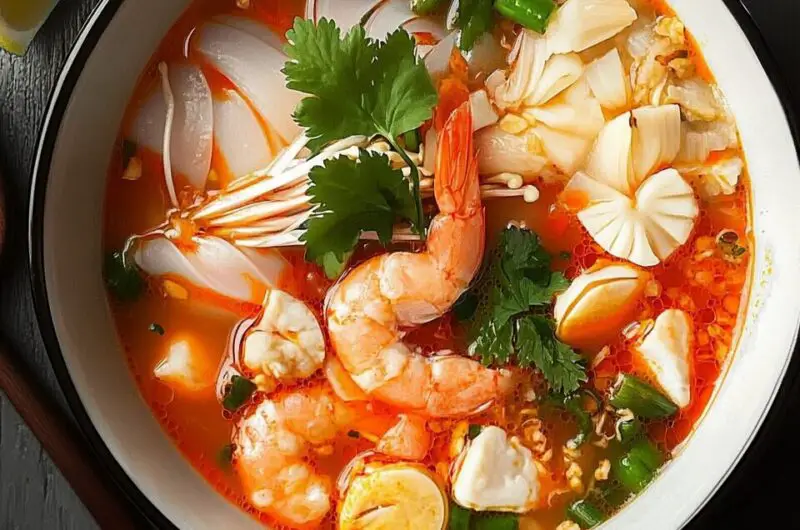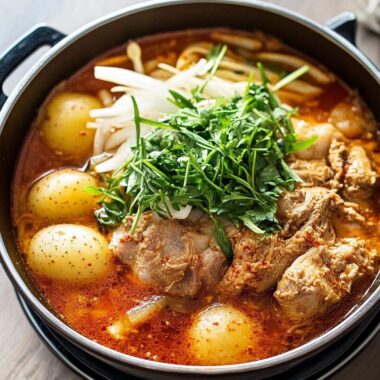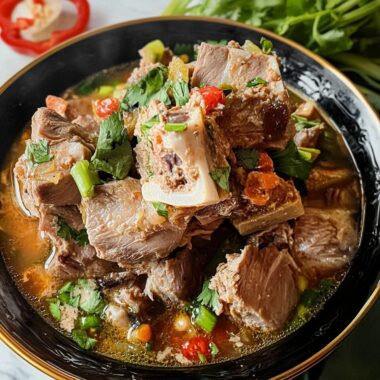The vibrant and aromatic Thai Tom Yum Soup is a heartwarming blend of bold ingredients like lemongrass, galangal, kaffir lime leaves, and chilies. This hot and sour soup is layered with flavor and finished with tender shrimp and fresh herbs, creating a dish that’s both comforting and refreshing. Whether you’re seeking an immune boost or just a soul-satisfying meal, Tom Yum is an ideal choice. Its delicate balance of spice and citrus makes it a favorite for fans of Southeast Asian cuisine, and it comes together quickly, making it perfect for weeknight dinners or light, nourishing lunches.
Full Recipe:
Ingredients:
-
1 tablespoon oil (vegetable or coconut)
-
4 cups chicken stock
-
2 stalks lemongrass, cut into 2-inch pieces and smashed
-
3 kaffir lime leaves, torn
-
1-inch piece galangal or ginger, sliced
-
3 Thai chilies, smashed (adjust for heat)
-
1 small onion, sliced
-
1 cup mushrooms, halved
-
1 medium tomato, cut into wedges
-
1 1/2 tablespoons fish sauce
-
1 teaspoon sugar
-
1/2 pound medium shrimp, peeled and deveined
-
2 tablespoons lime juice (or to taste)
-
Fresh cilantro for garnish
Directions:
-
Heat the oil in a large pot over medium heat. Add the sliced onions and cook for 2 minutes until fragrant.
-
Pour in the chicken stock and bring to a simmer.
-
Add lemongrass, kaffir lime leaves, galangal, and Thai chilies. Simmer for 5-10 minutes to infuse the broth.
-
Add the mushrooms and tomato to the pot. Simmer for 5 more minutes.
-
Stir in fish sauce and sugar.
-
Add shrimp and cook just until pink, about 2-3 minutes.
-
Remove from heat and stir in lime juice.
-
Strain soup to remove solids, if desired, or leave rustic.
-
Garnish with chopped cilantro and serve hot.
Prep Time: 10 minutes | Cooking Time: 20 minutes | Total Time: 30 minutes
Kcal: 150 kcal | Servings: 4 servings
The Bold, Bright World of Tom Yum Soup: Thailand’s Iconic Hot and Sour Delight
Thai cuisine is known for its electrifying layers of flavor salty, sour, sweet, spicy, and umami all coexisting in harmony. Among its standout dishes, Tom Yum Soup holds a special place as a quintessential example of how simple ingredients can create an incredibly complex and invigorating dish. Whether served at roadside stalls in Bangkok or in high-end Asian restaurants around the world, Tom Yum continues to enchant with its dynamic taste and fragrant broth.
Origins and Cultural Significance
The name Tom Yum comes from two Thai words: “Tom”, meaning “to boil” or “to cook,” and “Yum”, referring to a kind of Thai salad characterized by its spicy and sour flavor profile. Put together, Tom Yum represents a broth-based dish known for its explosive medley of tangy, spicy, and savory elements.
Originally from Central Thailand, this soup has become deeply embedded in the nation’s culinary identity. Over the years, it has been embraced across regions, with each area adding its own interpretation, ingredients, and heat level. For many Thais, Tom Yum is a comfort food, a go-to meal for rainy days, post-work dinners, or even a cold remedy thanks to its zesty ingredients and warming spice.
What Makes Tom Yum Unique?
Tom Yum stands out because it doesn’t rely on cream, butter, or heavy thickeners to create depth. Instead, its brilliance lies in its aromatic ingredients and herbal base. Lemongrass, galangal (a cousin to ginger), kaffir lime leaves, Thai bird’s eye chilies, and fish sauce form the essence of the soup.
The result? A light, broth-based soup that packs a punch. The broth is typically clear and shimmering, although some regional variations include evaporated milk or chili paste to create a creamy version known as Tom Yum Nam Khon.
When finished with a squeeze of fresh lime juice and topped with herbs like cilantro or Thai basil, Tom Yum becomes the embodiment of balance. It’s sour without being overpowering, spicy without being punishing, and savory enough to satisfy.
Different Variants of Tom Yum
While the core of Tom Yum remains consistent, there are several popular variations that showcase the soup’s adaptability:
1. Tom Yum Goong
This is perhaps the most famous version internationally, made with shrimp (“goong” means shrimp in Thai). The delicate sweetness of shrimp pairs wonderfully with the citrusy broth.
2. Tom Yum Gai
This chicken version swaps out seafood for tender slices of chicken, often favored by those who prefer meatier textures.
3. Tom Yum Talay
A seafood lover’s dream, this variant includes a mix of shrimp, squid, mussels, and sometimes fish, bringing the ocean’s richness to the dish.
4. Tom Yum Nam Khon
This creamy version of Tom Yum incorporates either evaporated milk or coconut milk along with Thai roasted chili paste (nam prik pao) to create a richer, creamier texture.
5. Vegetarian Tom Yum
Easily adapted for plant-based diets, the vegetarian version omits fish sauce and seafood in favor of tofu, mushrooms, and soy-based umami boosters like tamari or mushroom broth.
Health Benefits of Tom Yum Soup
This soup is more than just a taste sensation it’s a nutritional powerhouse. Let’s look at some of the health benefits associated with its key ingredients:
-
Lemongrass: Known for its anti-inflammatory and anti-fungal properties, lemongrass also aids in digestion and is believed to help lower cholesterol.
-
Galangal: A natural immune booster, galangal has antimicrobial properties and supports digestive health.
-
Kaffir Lime Leaves: Rich in antioxidants and vitamin C, these leaves can help detoxify the body and support healthy skin.
-
Chilies: Capsaicin, found in Thai chilies, boosts metabolism, helps with congestion, and provides pain relief.
-
Lime Juice: A potent source of vitamin C that strengthens immunity and aids in detoxification.
Because Tom Yum is low in calories and fat (especially in its clear broth versions), it’s a perfect dish for those looking to eat healthy without sacrificing flavor.
Tips for Perfecting Tom Yum at Home
If you’re preparing Tom Yum at home, here are a few helpful tips to make sure your soup hits the mark:
-
Smash the aromatics: Don’t finely chop the lemongrass or galangal; instead, give them a good smash with the back of a knife to release their oils before simmering. This allows the broth to absorb maximum flavor.
-
Don’t overcook the shrimp: They cook quickly and should be added towards the end to keep them tender.
-
Balance is key: Always taste your broth before serving. Adjust with more lime for sourness, fish sauce for saltiness, or chili for heat. The harmony of flavors is what makes Tom Yum extraordinary.
-
Use fresh ingredients: Whenever possible, opt for fresh lemongrass, galangal, and kaffir lime leaves. If unavailable locally, many Asian markets offer frozen versions that are a good substitute.
How to Serve and Pair Tom Yum
Traditionally, Tom Yum is served hot and eaten as either an appetizer or a main course. It’s often accompanied by a side of steamed jasmine rice, which helps mellow out the intensity of the broth and makes for a complete meal.
For those planning a Thai-themed dinner, Tom Yum pairs beautifully with dishes like:
-
Pad Thai or Pad See Ew (Thai stir-fried noodles)
-
Thai green or red curry
-
Som Tum (spicy green papaya salad)
-
Spring rolls or satay skewers
Beverage-wise, a cooling Thai iced tea or a citrusy mocktail works well to offset the spice.
Why Tom Yum Stands the Test of Time
In a world where food trends come and go, Tom Yum Soup remains a timeless classic. Its ability to comfort, nourish, and excite the palate makes it more than just a soup it’s a sensory experience. The aroma alone, as it simmers on the stovetop, can transport you to a bustling Thai kitchen.
It also exemplifies the best of Thai cooking: balancing contrast, honoring natural ingredients, and layering flavor. Whether you’re cooking it at home or enjoying it at your favorite Thai restaurant, Tom Yum Soup is a dish that never gets old.
Conclusion:
Tom Yum Soup is much more than just a spicy broth it’s a bold expression of Thailand’s culinary artistry. From its humble origins to its global popularity, this hot and sour soup is loved for its invigorating flavors, versatility, and health benefits.
With just a handful of ingredients and under 30 minutes of cooking time, you can enjoy a dish that feels like a tropical getaway in a bowl. Whether you prefer it clear and light or rich and creamy, with seafood or veggies, Tom Yum adapts to your mood and dietary needs without ever compromising on taste.








